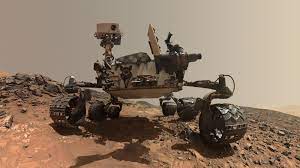Module 3: What are the types of computer intelligence?

Module 3 – High School
This will cover the main ways computers build intelligence, including narrow, Artificial General Intelligence and Super AI.
Part 1 – Learn about the 7 types of AI, which are in use now, which are being developed now, and which ones are still theory.
Part 2 – Understand the types of tasks/skills to be used in the Mars rovers and the types of data which could be used for the AI.
Part 3 – Think about the design of an AI for Mars, the type of AI and what data it would need to do the job you want it to do.
Part 1 -Seven Types of AI
Main Categories of AI
- Narrow Artificial Intelligence (NAI) is an AI tool designed to do very specific actions or steps. Narrow AI is also called “weak” AI, as the took can make decisions, but only for a very narrow task. These AI tools are very good for one cognitive skill, like vision, or navigation, but cannot independently learn skills beyond what it is trained to do. These are often used for machine learning and neural networks to do talks like natural language processing where an AI can convert voice commands to actionable tasks -“Alexa, dim the lights”, but it cannot do tasks beyond that. Examples are things like image recognition software, virtual assistants like Alexa and self driving cars.
- Artificial General Intelligence (AGI) is an AI that can learn and think and conduct a wide array of skills and behaviors much like people. This is also called “strong” AI as it can perform tasks that can be multi-functional and human-like. This AI is currently being developed, but it is in the early stages. There are not yet programs or AI systems that can create AGI.
- Super Intelligence or Artificial Super Intelligence (ASI) is the highest level of intelligence that could be created and it is only theory at this point. In this kind of AI, the computer would learn faster than humans and the intelligence of the AI would surpass that of humans. This is what could be called self-aware AI and it would go beyond anything humans can currently do in terms of thinking, problem solving, designing, creating.
Types of AI based on the Categories and Functionality
Within the Main Categories, you can break out several sub-types of AI.
Narrow AI:
- Reactive Machine – something that is reactive responds to some stimuli or requests. Reactive machines respond to requests by doing tasks, but they do not have memory and cannot remember previous responses when they respond again. This means they cannot learn from memory or past experiences and reinforcement learning. Reactive machines can only respond to a limited set of commands or inputs. This is the most common form of AI being used right now. Some examples of reactive machines are simple and well known like spam filters or Spotify recommendations. However, Deep Blue the IBM chess playing computer was also a reactive machine.
- Limited Memory AI – This is an AI which has some memory and can store data and past experiences and use that memory to make predictions or future decisions. This AI can build it useful knowledge base and complete tasks or actions based on the additional knowledge it has learned through a process called “Deep Learning”. Deep Learning uses a process for the algorithms which mimic methods the human brain uses to learn. Examples of Limited Memory AI include self-driving cars, some GPT chatbots and some autonomous robots currently being developed.
Artificial General Intelligence:
- Theory of Mind AI – Theory of mind AI falls under AGI as it is a much higher cognitive machine that can read human emotions and understand the “feelings” of others including humans and other robots. The term “Theory of Mind” comes from psychology where it is the ability of humans to read the emotions of others and make decisions based on the emotions it reads. This would allow a robot to know if a human is sad or happy, or in distress. This AI has not been developed and will be difficult to develop as human emotions are very complex and machines will need a long time and a lot of data to do this correctly.
Super Artificial Intelligence:
- Self Aware AI -this is an AI system that has self-awareness like a human and recognizes itself as a being. This is the ultimate intelligence and some call this the AI point of singularity which means that it is AI beyond Theory of Mind and it is an ultimate intelligent being. This AI would be beyond the control of humans as it would have choice and autonomy in decision making. There are currently no examples of this form of AI, but one could image that some day this could be developed.
Part 1: Deliverable
In thinking about the Activities you have completed in Module 1 and 2, what kind of AI do you think a Mars Rover should or could have? Using the form below, fill out how you think each of these types of AI could be used on Mars for Rovers to collect information.
Module 3 HS Part 1 Seven types of AI
Part 2 – Tasks and Skills for Mars Rovers
Rovers have a lot of jobs on Mars. Rovers collect weather related data, take images of the landscape, drill holes and extract samples for analysis and conduct experiments related to preparing for humans visiting Mars. For more on some of these technologies that being developed and used, see this NASA Mars 2020 Rover website.
We are very interested in how the Mars Rover will navigate the surface of Mars. As you learned in Module 2, programs are used to help the rover go in a pattern on Mars. In Module 2, you did not worry about the terrain and elevation, you only worried about programming to go in a pattern. In this part, you will work through the NASA Mars Trek exercise to learn about how the Mars Rover uses satellite, and camera data for navigation.
Read and work through this Mars Trek Exercise. Make sure to do every part so that you know how to navigate along the terrain.
Especially focus on Part 4 Explore the topography

and Part 5 Measuring Distances

Once you use the measure distance tool, go back to the tools. Using the same map as you used before and make sure you have the two layers added in so that it looks like the image below.

Go over to the x on the layers and close the tab. Look to the upper right in your image for the Tools bar. Open the Tool Bar and pick the “Elevation Profile tool: It should look like the image below.

Use the Line feature and the window to your right will close. Draw a line as shown below

Now hit submit. You should see an image like the one below

Part 2 – Deliverable
- Go into the Mars track and draw a line on the same plot, draw an elevation map from the outflow channel to the Perseverance landing ellipse. Screen shot this image and paste into a Word/Pages/PowerPoint document.
- Now draw an elevation map from the Perseverance landing ellipse to the Northern Inflow Channel. Screen shot this image and paste into a Word/Pages/PowerPoint document.
- Which of these elevations and distances would be the easiest to program for the rover and why might one be easier than another? What terrain features might you need to be aware of that could make your rover tip over?
Part 3 – Designing AI to help navigate Mars Rovers
In part 3 you will think about how to move the Rover across the Martian terrain and what data and how the different types of AI could be used in your design. You can use this worksheet document to record your work. We will use the Major Features map.

- Go in to the Major Features Map. List the eight Areas of interest marked by the map above in the worksheet and tell a little (but not everything about the site). you may need to zoom out on the map a little to see all the sites shown.
- You want to visit all the sites, but you want to have the least elevation change as possible for your rover. To figure this out, you will need to map between all the points to see what the best paths are. For each of the combination of points you will generate an elevation map. Figure out how you want to number the points of interest, create a list of numbers and the names of your point. For example Point 1 could be the point on the far right called the Elysium Volcanic Region. You would then draw a map from there to each of the points over on the left. Then you would go to the second point moving left and call it point 2 – Ares Vallis. You would draw from that point to all the other points except, the Volcanic Region as you did that one in stage 1. Go though and fill out the worksheet and make sure to screenshot the image and put into the worksheet. The image should look something like the one in the worksheet. Now, you have to figure out the best route. Look at the worksheet for additional directions
- What you did in part 2, is what humans have to do now, as there is no AI for the Rover as of yet. Now, let’s think and design a way to have AI do this work. If you had to have each of these types of AI to do the same job what data would they need and how it would figure out the best route. Use the worksheet to help with this.
Link to turn in your work for parts 1-3

